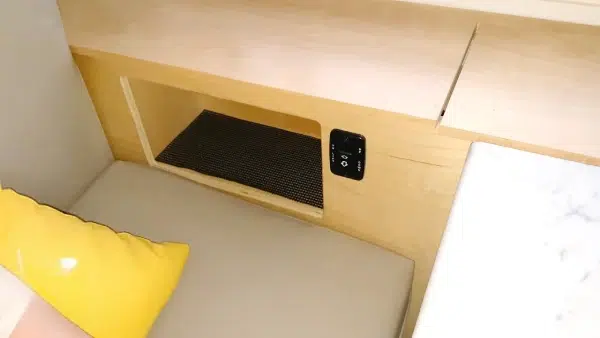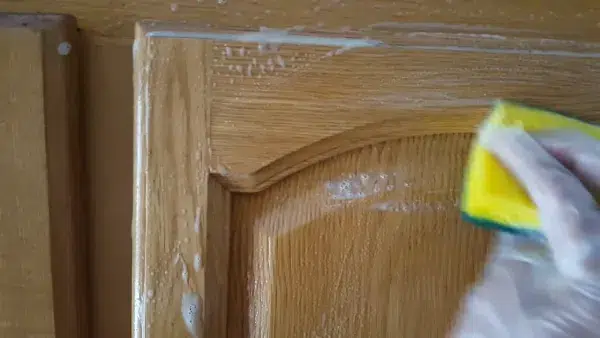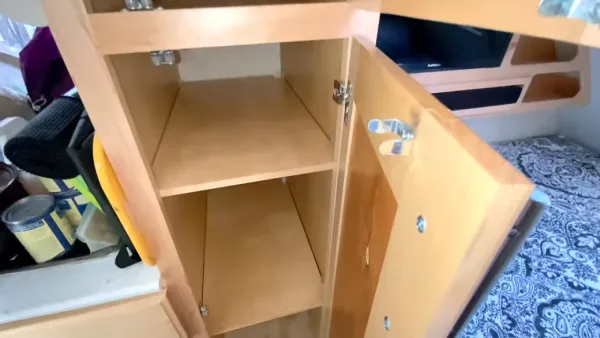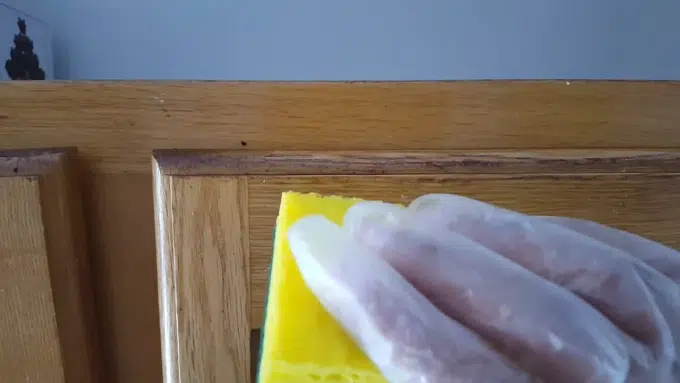Last Updated on April 29, 2023
Keeping your RV tidy and clean is essential for an enjoyable and comfortable life on the road. However, maintaining wooden cabinets in your RV can be daunting, especially if you don’t know how to clean them properly.
Wood cabinets in RVs are exposed to various elements, such as dirt, grease, and moisture, which can cause damage if not cleaned regularly. The easiest way to clean your wood cabinet is to remove everything and then clean it with vinegar and water.
Through this article, we’ll provide you with a step-by-step guide on how to clean wood cabinets in your RV like a pro. Get ready to learn how to keep those wooden cabinets sparkling clean.
How to Clean Wood Cabinets in RV: Simple Steps

Cleaning the wooden cabinets in your RV is an important task to maintain their appearance and longevity. Dust, dirt, and grime can accumulate on the surface of the cabinets, making them look dull and dirty.
To properly clean the wood cabinets in your RV, you will need to gather a few supplies. It is important to have everything ready before starting the cleaning process. Here are the supplies you will need:
- Dry cloth
- Clean damp cloth
- Vinegar
- Water
Ensure the dry cloth is clean and free of debris or dirt. The same goes for the clean damp cloth, which should be damp but not soaking wet. For the vinegar and water solution, mix equal parts of vinegar and water solution in a spray bottle.
To clean your RV’s wood cabinets effectively, follow these simple steps.
Step 1: Remove Everything from the Cabinets
When cleaning wood cabinets in an RV, the first step is to remove everything from the cabinets. This will make cleaning easier and ensure you don’t miss any spots.
Before removing items from the cabinets, ensure you have a safe place to put them. You don’t want to leave them on the counter or table where they could get knocked over or damaged.
Step 2: Wipe Down the Cabinets with a Dry Cloth
After gathering all the necessary supplies, the next step is to wipe down all the cabinets with a dry cloth. This is an important step because it helps remove any loose debris or dust that may have accumulated on the surface of the wood.
Using a clean and dry cloth is important when wiping down the cabinets. Avoid using a wet cloth at this stage, as excess moisture can damage the wood. Instead, opt for a microfiber cloth or a soft cotton rag.
Start by wiping down the exterior of each cabinet, including the doors and handles. Be sure to get into all the crevices and corners where dirt and grime can accumulate.
Next, move on to cleaning the interior of each cabinet. Remove any items stored inside and set them aside for now. Then, wipe down all surfaces inside each cabinet using your dry cloth.
Step 3: Apply Vinegar and Water Solution to the Cabinets
Applying vinegar and water to wood cabinets in your RV is an effective way to remove dirt, grime, and stains. Vinegar is a natural cleaning agent that can help remove grease and disinfect surfaces while being safe for use on wood.
Mix equal white vinegar and water solution in a spray bottle to create the solution. Shake well before using. Add baking soda to the vinegar and water mixture if any stubborn stains or spots won’t come off.
This will create a paste that can be applied directly to the stain with a soft-bristled brush. Wipe it off with a damp cloth after letting it sit for a few minutes.
Step 4: Wipe Down Cabinets with a Clean Damp Cloth
After applying the vinegar and water solution to your wood cabinets, it’s time to wipe them down with a clean damp cloth. This step is essential to remove any remaining dirt or grime from the cabinets.
Make sure your cloth is clean and damp, not soaking wet. Too much moisture can damage the wood and cause warping or swelling. Wipe toward the wood grain to avoid leaving streaks or scratches on the surface.
You can use a mild soap solution if you notice stubborn stains or marks that won’t come off with a damp cloth. Mix a small amount of dish soap with warm water and dip your cloth into the mixture. Wring out excess liquid and gently scrub the affected area. Rinse with a damp cloth afterward.
Step 5: Dry the Cabinets
After cleaning your RV wood cabinets with a damp cloth, it’s essential to dry them thoroughly to prevent water damage. Leaving excess moisture on the cabinets can cause warping or discoloration over time.
You can use a clean cloth or paper towel to dry the cabinets. Start at the top of the cabinet and work your way down, wiping all surfaces, including shelves and corners. Pay extra attention to areas where water may have pooled, such as around handles or knobs.
If you notice any remaining streaks or spots after drying, go back over those areas with a clean and dry cloth until they are completely gone. It’s important to leave no moisture behind.
Step 6: Restore Shine to the Wood
You’ll need a few additional supplies to restore shine to the wood of your RV cabinets. You can use either furniture polish or wood oil to achieve a shiny finish.
To use furniture polish, simply spray it onto a clean cloth and wipe down the cabinets. Be sure to follow the manufacturer’s instructions for the best results. Furniture polish is great for adding shine to your cabinets, but it may not provide long-lasting protection.
How to Maintain Your Clean RV Wood Cabinets?

Follow these simple maintenance tips to ensure your clean cabinets stay in top shape.
Use Gentle Cleaning Products
Keeping your RV wood cabinets clean is crucial to their longevity. Harsh chemicals can wreak havoc on wood, leading to damage and fading over time. To ensure your cabinets stay in great condition, use gentle cleaning products.
Mix one part vinegar and one part water to create a natural cleaning solution. This solution will remove dirt and grime while protecting your wood cabinets from damage.
Dust regularly
Dust accumulation on your cabinets may seem like a minor issue, but it can quickly escalate into a larger problem. Dirt, grime, and dust particles can cause irreparable damage to your cabinets, including discoloration and scratches.
Using a soft cloth such as a microfiber cloth ensures no scratches or marks are left behind. By dusting your RV cabinets regularly, you’ll save yourself the hassle and expense of repairing or replacing them in the future.
Wipe Spills Immediately
Spills can happen anytime in an RV, leading to serious damage if not dealt with quickly. Any spills should be wiped up immediately before they can penetrate the wood’s surface.
Use a dry cloth to absorb the spill, dampen a second cloth with water, and wipe the area clean. Do not use excessive water, as it could cause warping and swelling of the wood.
Use a Protectant
Consider using a protectant to keep your RV wood cabinets in top shape. These protectants protect against scratches and other damage during normal use. They also help to maintain the finish on your wood cabinets, leaving them looking like new for years to come.
You can choose from a range of protectants, including wax and polish, specially formulated for wood use.
What is the best way to clean the inside of RV wooden cabinets?

Cleaning the inside of RV wooden cabinets is an essential task that should not be overlooked. One of the best ways to clean RV wooden cabinets is by using a 50/50 solution of vinegar and warm water.
This solution is natural and gentle yet effective in removing dirt, dust and grime from the cabinets. Simply pour the solution into a spray bottle, mist on cabinets, and let it sit for a minute or two, then wipe clean with a soft cloth.
Using this method not only cleans the cabinets but also eliminates any lingering odors leaving them smelling fresh and clean.
Is vinegar safe for RV wood cabinets?
Vinegar is safe for RV wood cabinets. It is a natural, gentle cleaner that removes dirt and grime without damaging or discoloring the wooden surface.
It also helps to eliminate any lingering odors giving the cabinets a fresh and clean scent. Moreover, since it is natural and free of toxic chemicals, it is a safer alternative than harsh chemical cleaners that can cause eye and skin irritation.
Can you use baking soda to clean RV wood cabinets?
Baking soda is another natural and safe alternative that can be used to clean RV wood cabinets. After wetting your brush with warm water, add a little baking soda and scrub away on the cabinets.
Baking soda’s fine abrasive properties help remove tough stains and grease, leaving the cabinets looking clean and new. But you should be cautious when using baking soda on delicate surfaces, as excessive scrubbing can cause scratches or discoloration.
Can you clean RV cabinets before painting?
Cleaning RV cabinets before painting ensures a smooth and long-lasting finish. It is imperative to clean all the cabinets, doors and drawer fronts with a pre-paint cleaner to remove any dirt, grease, or other contaminants that may hinder the paint’s adherence.
Failure to prepare the surface adequately may result in poor paint adhesion, bubbling or cracking, and an uneven finish. Therefore, cleaning the cabinets is essential for achieving a professional-looking result.
Follow Simple Steps to Refresh Your RV Wood Cabinets
RV wood cabinets can be tough to clean, but you can do it with the right supplies and preparation. Following the simple steps outlined above, you can ensure your cabinets remain clean and shiny for years.
Regular cleaning and maintenance are key to keeping your RV’s wood cabinets in top condition. Avoiding harsh chemicals and using gentle solutions like vinegar and water will help preserve the natural beauty of the wood without causing damage or discoloration.
So whether you’re a full-time RVer or just taking a weekend trip, remember to take care of your wood cabinets. With these tips and tricks, you can keep them looking their best while enjoying all the comforts of home on the road. Happy travels!


